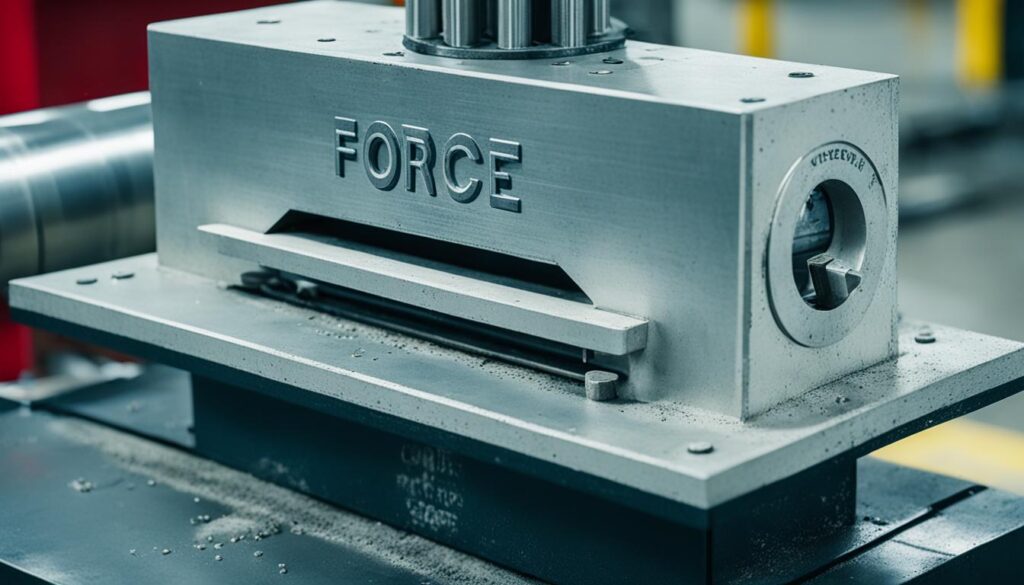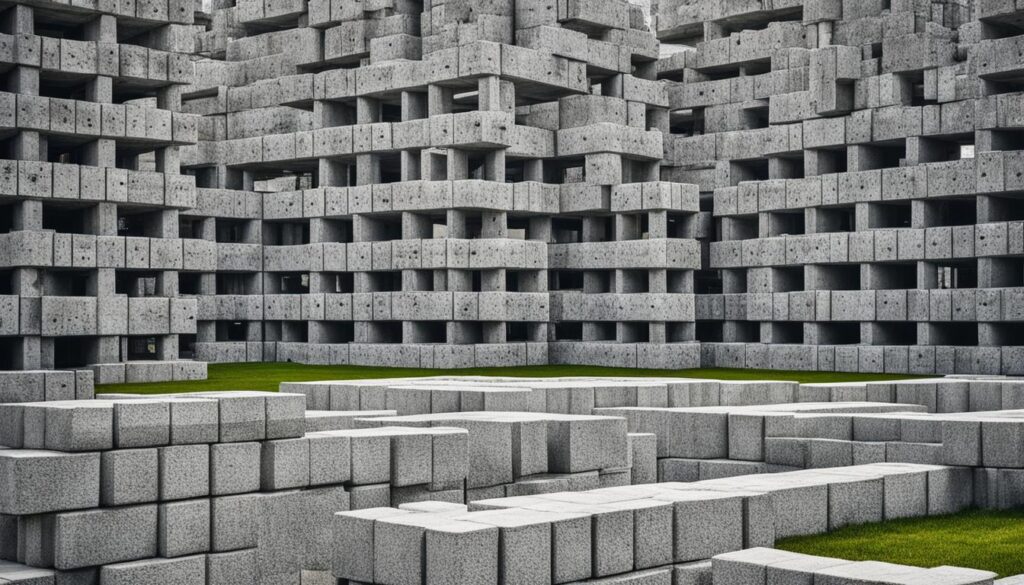Did you know that the United States produces over 1.5 billion concrete blocks annually, making it one of the most widely used building materials in the country? Concrete blocks, also known as cinder blocks or concrete masonry units (CMUs), are an essential component of the modern construction landscape. These versatile and durable building blocks are used in a vast array of projects, from residential foundations to commercial high-rises, playing a crucial role in shaping the infrastructure that supports our communities.
Key Takeaways
- Concrete blocks are a widely used building material, with over 1.5 billion units produced annually in the United States.
- Concrete blocks are available in a variety of types, sizes, and compositions to suit different construction needs.
- Compressive strength is a key factor in determining the durability and load-bearing capabilities of concrete blocks.
- Proper testing and measurement of compressive strength are crucial to ensuring the quality and safety of concrete block construction.
- Factors like raw material quality, water-cement ratio, and aggregate ratios can significantly impact the compressive strength of concrete blocks.
What are Concrete Blocks?
Concrete blocks, also known as cement blocks or construction blocks, are a type of masonry unit made primarily of concrete. These versatile building materials are rapidly gaining popularity in the construction industry, replacing traditional brickwork in many applications.
Composition and Characteristics
Concrete blocks are composed of a mixture of cement, water, and aggregates such as sand, gravel, or crushed stone. This combination creates a durable and long-lasting building material that is fire-resistant, insect-resistant, and low-maintenance. Concrete blocks are known for their strength, making them a popular choice for the construction of walls, foundations, and other structural elements.
| Characteristic | Description |
|---|---|
| Durability | Concrete blocks are highly durable and can withstand a significant amount of wear and tear, ensuring the longevity of any structure built with them. |
| Fire Resistance | Concrete is a non-combustible material, making concrete blocks an excellent choice for fire-prone areas or buildings that require enhanced fire safety. |
| Insect Resistance | Concrete blocks are resistant to insect infestations, providing a more secure and low-maintenance option for construction projects. |
| Versatility | Concrete blocks can be used in a wide range of construction projects, from residential homes to commercial buildings and industrial facilities. |
The unique properties of concrete blocks have made them a preferred choice for many construction projects, offering a superior alternative to traditional brickwork and other masonry materials.
Compressive Strength: The Key to Durability
Concrete blocks are a popular choice in construction due to their exceptional durability, and at the heart of this durability lies their compressive strength. Compressive strength refers to the amount of pressure that the material can withstand before it breaks, or, in other words, the maximum crushing stress that a concrete block can take.
The ability of a concrete block to endure compression stresses applied to its surface is a highly essential physical attribute of this widely used construction material. Compressive strength is a crucial factor in determining the structural integrity and load-bearing capacity of a building or structure.
Concrete block compressive strength is an essential element of structural designing, as it helps engineers and architects assess the load-bearing capabilities of the materials they use. By understanding the compressive strength of concrete blocks, construction professionals can ensure that the structures they design are safe, stable, and able to withstand the demands placed upon them.
| Compressive Strength Range (psi) | Typical Applications |
|---|---|
| 1,000 – 3,000 | Decorative, non-load-bearing walls |
| 3,000 – 5,000 | Residential and light commercial construction |
| 5,000 – 8,000 | Commercial and industrial construction |
| 8,000+ | High-rise buildings, bridges, and other heavy-duty structures |
By understanding the importance of concrete block compressive strength and how it is measured, construction professionals can make informed decisions that ensure the durability and longevity of their projects.
Types and Standards of Concrete Blocks
The world of concrete blocks, also known as concrete masonry units (CMUs), is a diverse one. These essential building materials come in a variety of types, each tailored to specific construction needs. From solid to hollow, load-bearing to non-load-bearing, the range of concrete block options is both impressive and crucial for successful projects.
Solid and hollow concrete blocks are the two primary categories. Solid blocks offer superior compressive strength, making them ideal for load-bearing walls and foundations. Hollow blocks, on the other hand, are lighter and more versatile, finding use in both load-bearing and non-load-bearing applications.
Beyond these broad classifications, concrete blocks can be further differentiated by their density. Ultralow, light, normal, and high-density varieties cater to diverse construction requirements, each with its own unique characteristics and performance capabilities.
| Block Type | Compressive Strength (psi) | Common Applications |
|---|---|---|
| Ultralow Density | 650 – 1,000 | Non-load-bearing walls, interior partitions |
| Light Density | 1,000 – 1,900 | Non-load-bearing walls, interior partitions |
| Normal Density | 1,900 – 3,000 | Load-bearing walls, foundations |
| High Density | 3,000 – 5,000+ | Load-bearing walls, foundations, critical structures |
Regulatory agencies, such as the American Society for Testing and Materials (ASTM), establish standards for the compressive strength of concrete blocks. These guidelines ensure that the blocks used in construction meet the necessary degree of strength and durability, safeguarding the integrity of the built environment.
Testing and Measurement of Compressive Strength
Evaluating the compressive strength of concrete blocks is a critical aspect of quality control in the construction materials industry. Concrete block compressive strength testing is conducted to ensure the blocks meet established standards and can withstand the demands of various building applications.
Testing Procedures
The compressive strength of concrete blocks is typically measured using a standardized testing process. Here’s a closer look at the steps involved:
- Sample Selection: During the manufacturing process, a random sample of 8 full-size concrete blocks is selected for testing.
- Compression Testing: The selected blocks are placed in a compressive testing machine (CTM) and subjected to increasing pressure until they reach their maximum load-bearing capacity.
- Strength Calculation: The compressive strength of each block is calculated by dividing the maximum load by the block’s total cross-sectional area.
- Averaging Results: The final compressive strength of the concrete masonry unit (CMU) is determined by averaging the strengths of all 8 tested blocks.
This rigorous testing process helps ensure the concrete blocks meet or exceed the required compressive strength standards, which are essential for maintaining the structural integrity and safety of buildings and other construction projects.

Proper testing and measurement of concrete block compressive strength is a critical component of quality control in the construction materials industry, ensuring that the end product meets the necessary performance and safety requirements.
Factors Affecting Compressive Strength
The compressive strength of concrete blocks is heavily influenced by the quality and composition of the raw materials used in their production. These materials, which primarily include cement, aggregates, and water, all play a crucial role in determining the overall durability and load-bearing capacity of the final concrete masonry units.
Raw Material Quality
The quality of the cement, aggregates (both fine and coarse), and water used in the concrete mix is paramount. Impurities or inconsistencies in these components can significantly impact the compressive strength of the concrete blocks. Careful selection and monitoring of raw material sources are essential to ensure consistent and high-quality concrete blocks.
Water/Cement Ratio
The water-to-cement ratio is an inverse relationship with compressive strength. A higher water-to-cement ratio leads to a weaker concrete mix, as the excess water can create voids and reduce the density of the hardened concrete. Maintaining the optimal water-to-cement ratio is crucial to achieving the desired compressive strength in concrete blocks.
Aggregate Ratios
The proportions of coarse and fine aggregates, as well as the overall aggregate-to-cement ratio, play a significant role in the compressive strength of concrete blocks. A well-balanced blend of aggregates, designed to maximize the packing density and reduce voids, can contribute to enhanced compressive strength and overall structural integrity.
| Raw Material | Impact on Compressive Strength |
|---|---|
| Cement | Higher cement quality and content increases compressive strength |
| Aggregates | Proper gradation and proportions of coarse and fine aggregates improve compressive strength |
| Water | Lower water-to-cement ratio results in higher compressive strength |
concrete blocks
Crafting high-quality concrete blocks is a meticulous process that combines precision and patience. The unique composition of the concrete mixture, with its higher sand and lower gravel content, is carefully engineered to meet the specific demands of block manufacturing.
The first step in this process is to meticulously measure the required amounts of cement, aggregates, and water. These dry ingredients are then thoroughly mixed, with water gradually added to achieve the perfect consistency. Throughout the mixing stage, the mixture’s quality is closely monitored and adjusted as needed.
The concrete block molds, whether made of wood, plastic, or metal, play a crucial role in shaping the mixture into the desired form. These molds are filled with the carefully prepared concrete, which is then allowed to cure. This curing process strengthens the cement and aggregates, ensuring the structural integrity of the final product.
The Key Steps in Concrete Block Manufacturing
- Measuring the precise quantities of cement, aggregates, and water
- Thoroughly mixing the dry ingredients
- Gradually adding water to achieve the ideal consistency
- Monitoring and adjusting the mixture throughout the mixing process
- Filling the concrete block molds with the prepared mixture
- Allowing the concrete to cure, strengthening the cement and aggregates
| Step | Description |
|---|---|
| Mixing | The concrete mixture is prepared by precisely measuring the cement, aggregates, and water, and then thoroughly mixing the dry ingredients before gradually adding water to achieve the desired consistency. |
| Molding | The concrete block molds, made of various materials like wood, plastic, or metal, are used to shape the concrete mixture into the required form. |
| Curing | After the molds are filled, the concrete is allowed to cure, a process that strengthens the cement and aggregates, ensuring the structural integrity of the final concrete blocks. |
Applications and Uses
Concrete blocks are a versatile construction material that finds applications across a wide range of projects, from residential homes to commercial buildings and infrastructure. Their exceptional strength, durability, and adaptability make them a popular choice for builders and developers alike.
In the residential sector, concrete blocks are commonly used for building foundations, walls, and even floors. Their load-bearing capabilities make them ideal for supporting the weight of a home, while their insulative properties can enhance energy efficiency. Concrete blocks are also a popular choice for retaining walls, garden walls, and fences, offering both structural integrity and aesthetic appeal.
The commercial and industrial construction industries also rely heavily on concrete blocks. They are used to construct the load-bearing walls of office buildings, warehouses, and other commercial structures. Concrete blocks can also be found in the foundations and walls of schools, hospitals, and other public facilities, where their strength and fire-resistance are highly valued.
Concrete blocks are not limited to vertical construction; they are also used in the creation of infrastructure projects. Bridges, tunnels, and other transportation-related structures often incorporate concrete blocks in their design, taking advantage of the material’s resilience and longevity.
| Application | Residential | Commercial | Infrastructure |
|---|---|---|---|
| Foundations | ✓ | ✓ | ✓ |
| Walls | ✓ | ✓ | ✓ |
| Floors | ✓ | ✓ | – |
| Retaining Walls | ✓ | – | ✓ |
| Bridges | – | – | ✓ |
| Tunnels | – | – | ✓ |
The versatility of concrete blocks allows them to be tailored to meet the specific needs of a construction project, whether it’s for load-bearing capacity, insulation, or aesthetic considerations. This adaptability, combined with their inherent strength and durability, makes concrete blocks an essential component in the world of construction, building materials, and infrastructure.
Advantages and Limitations
Concrete blocks have become a popular choice among construction materials, offering a range of advantages that make them a versatile option for building projects. One of the key advantages of concrete blocks is their exceptional strength and durability, making them resistant to wear and tear over time. They are also highly fire-resistant and insect-resistant, reducing the need for ongoing maintenance and repairs.
Another notable advantage of concrete blocks is their ease of use during the construction process. Their uniform size and shape allow for efficient and straightforward installation, streamlining the building process. Additionally, concrete blocks can be made using recycled materials, making them a sustainable choice for eco-conscious construction.
However, concrete blocks do have some limitations. Their weight can pose challenges during transportation and installation, requiring specialized equipment and techniques. Furthermore, if not properly handled or installed, concrete blocks can be prone to cracking or chipping, potentially compromising the structural integrity of the building.
| Advantages of Concrete Blocks | Limitations of Concrete Blocks |
|---|---|
|
|
Overall, the advantages of concrete blocks make them a compelling choice for a wide range of construction projects, while their limitations can be addressed with proper handling and installation techniques. As with any building material, it is important to carefully weigh the benefits and drawbacks to ensure the best fit for a specific construction project.

Sustainability and Environmental Impact
Concrete blocks are emerging as a sustainable and environmentally-friendly building material. Their production process is relatively energy-efficient, with a lower carbon footprint compared to some other construction materials. Additionally, concrete blocks can be manufactured using recycled materials, reducing the demand for virgin raw resources and minimizing waste.
One of the key advantages of concrete blocks is their longevity. These durable structures can serve for decades, reducing the need for frequent replacements and the associated environmental impact. This long-lasting nature of concrete blocks contributes to more sustainable construction practices, as buildings made with these blocks require fewer resources over time.
| Sustainability Metric | Concrete Blocks | Traditional Bricks |
|---|---|---|
| Carbon Footprint | Lower | Higher |
| Recycled Content | Higher | Lower |
| Lifespan | Longer | Shorter |
Furthermore, the modular design of concrete blocks allows for efficient transportation and on-site assembly, reducing the energy consumption and emissions associated with construction. This, combined with their versatility in design and adaptability to various building applications, makes concrete blocks a practical and sustainable choice for green building projects.
In conclusion, the use of concrete blocks in construction can contribute to more environmentally-friendly and sustainable building practices. Their ability to be produced from recycled materials, their energy-efficient manufacturing process, and their long-lasting durability make them a compelling option for those seeking to reduce the environmental impact of their construction projects.
Conclusion
Concrete blocks have firmly established their place as a versatile and durable building material in the construction industry. Their exceptional compressive strength, fire resistance, and low-maintenance properties make them a practical choice for a wide range of projects, from residential structures to commercial buildings and infrastructure.
The manufacturing process, which involves carefully blending cement, aggregates, and water, is crucial in determining the overall quality and performance of concrete blocks. By understanding the factors that influence compressive strength, such as raw material quality, water-cement ratio, and aggregate ratios, builders can ensure the use of high-quality concrete blocks that will provide long-lasting structural integrity and support.
Moreover, the sustainability and environmental benefits of concrete blocks, including their potential for incorporating recycled materials and reducing carbon footprint, make them a responsible choice for modern construction. As the demand for sustainable and resilient building solutions continues to grow, concrete blocks are poised to play a vital role in shaping the future of the built environment.
